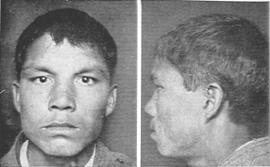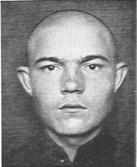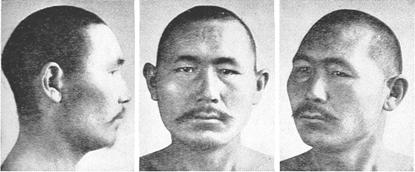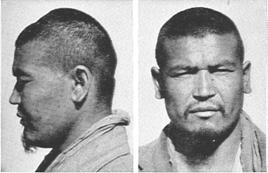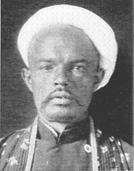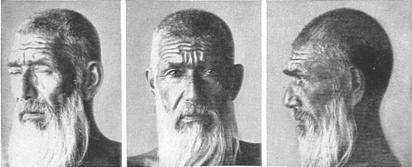|
(Photographic Supplement, Plate 3)
and in Turkestan The invasions of mongoloid peoples from central Asia during the millennium
from about 400 to 1400 A.D. caused the settlement of some Mongols proper
(Kalmucks) near the mouth of the Volga, and the partial Mongolizing of some
Finnic tribes, especially those which adopted Turkish speech. In Russian
Turkestan erstwhile white populations became Mongolized in varying degrees.
FIG. 2 (1 view, photo B.. N. Vishnevsky). A lighter-skinned, less mongoloid Chuvash. The median eyefold and snubbed nasal tip, with laterally oriented nostril axes, are Ladogan rather than mongoloid.
FIG. 3 (3 views, photo J. Wastl, Archiv für Rassenbilder, Bildaufsatz 2, Archivkarte 11, 1926. Herausgeber E. von Eickstedt, J. F. Lehmans Verlag, München). A Bashkir member of another tribe of Turkicized Finns living in the Kazan district and the southern Urals. This individual is almost completely mongoloid in the central Asiatic sense.
FIG. 4 (2 views, photo Gordon T. Bowles). An Uzbeg from Russian Turkestan. The Uzbegs are Turkish-speaking inhabitants of the central Asiatic khanates, of mixed origin. This individual shows a partially mongoloid condition usual among these people.
FIG.5 (1 view, photo B. N. Vishnevsky). A Tajik from Russian Turkestan; the Tajiks are Iranian-speaking farmers inhabiting the oases of some of the khanates, and the Pamir mountains to the south. While characteristically European in race, a few of the Tajiks show evidences of mongoloid admixture.
FIG. 6 (3 views, photo B. N. Vishnevsky). An Arabic-speaking native of Russian Turkestan. The remnants of the Arab invasions of the Middle Ages have been mostly absorbed by the Uzbegs, and those who retain their Semitic idiom have been in most cases racially altered. The old man shown here represents a common type in Turkestan regardless of speech or ethnic affiliation; a mixture between a mongoloid and a long-faced local Mediterranean strain, giving a pseudo-Armenoid appearance. Note the long, straight, coarse beard, a common feature among individuals of this type, which von Eickstedt calls Turanid.
|
